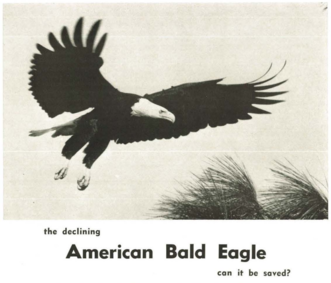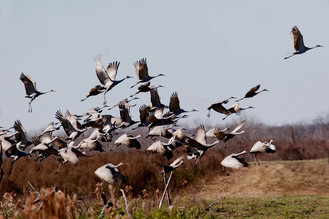 A 1969 edition of the Florida Wildlife Magazine described the plight of the Bald Eagle in Florida and across the United States. Since then, research and conservation action have brought these birds back from the brink.
No matter where you found yourself in peninsular Florida on the Fourth of July, you were likely within an easy drive of a site where you can see our national bird – but this hasn’t always been the case. In 1949, researchers estimated there were approximately 400 active Bald Eagle nests across the state. By 1969, this number had dropped nearly in half – and alarmingly, only about 60% of those nests produced any offspring. The return of the Bald Eagle from the brink of extinction is an incredible narrative of how research, public concern and legislation came together to save a beloved species.
Species declines are often caused by complex and interacting factors, and the decline of the Bald Eagle was no exception. As early as 1921, ecologists noted the population was decreasing and, in 1940, Congress enacted the Bald Eagle Protection Act, which prohibited the killing or selling of Bald Eagles. Florida Audubon and the Florida Game and Fresh Water Fish Commission (the predecessor to FWC) joined forces in an educational campaign to reduce illegal shooting of eagles. They showed the public that eagles posed no threat to humans or livestock and taught how to distinguish a brown-headed juvenile bald eagle from a vulture or another bird of prey. They also recognized, however, there were more significant causes for the species’ decline than illegal kills. As with many threatened species then and now, habitat loss played an enormous role in reducing population numbers. Florida Audubon led the charge in establishing the Cooperative Bald Eagle Sanctuary program, working with private landowners and agency partners to preserve 1.7 million acres of suitable habitat.
Even with those efforts, Bald Eagles were still in decline. The culprit? A widely-used pesticide called DDT was being washed into our waterways, where it contaminated the fish that make up the bulk of a Bald Eagle’s diet. When the birds ingested DDT, it led to a thinning of their eggshells, which would break or simply fail to hatch. In 1972, the federal government took the decisive step to ban all DDT use. With this pesticide ban, protections from hunting, and more protected habitat, the birds finally had a fighting chance to recover. Today, FWC estimates that there are 1,500 nesting pairs of Eagles across the state, one of the highest concentrations in the continental United States – a true conservation success story.
 Florida's birds display a tremendous range of coloration. From left to right, top to bottom: Roseate Spoonbill, Red-cockaded Woodpecker, Purple Gallinule, Snowy Egret, Prothonotary Warbler, Limpkin, Blue Jay, Fish Crow, Northern Cardinal.
Generations of scientists and naturalists have been entranced by the stunning diversity of birds, with their marked variations in sizes, shapes, vocalizations, behaviors and colors. For the next few months, we will be dedicating a section of our newsletter to exploring how and why birds are so varied.
Shades of gray, brown and black are the result of pigments called melanins that birds produce in their feathers and on their skin. These are the pigments responsible for the deep black of a crow’s feathers and the dappled camouflage of a Great Horned Owl. Many birds also have more melanins on their flight feathers or on the tips of their tails, and not just for decoration – the pigments actually strengthen these feathers and protect them from wear and tear.
To achieve vibrant red and yellow colors, birds use pigments called carotenoids. Unlike melanins, birds cannot produce carotenoids themselves and must obtain these pigments from plants. Songbirds like cardinals and goldfinches get their carotenoids from the fruits and berries they eat. The Roseate Spoonbill isn’t so keen on plants – it gets its pink colors from eating crustaceans, which in turn get their coloration from eating photosynthetic algae.
Some of the most dazzling colors in the rainbow of avian plumage aren’t derived from pigments at all but are actually the result of what is known as structural coloration. Think of the gem-like gorget of a Ruby-throated Hummingbird and the way the color of the feathers can change from black to red depending on the angle from which you see them. The feathers are structured so they act like a prism, separating light and reflecting it back in a beautifully dynamic display.
Surprisingly, matte blue is also a structural color. There are very few blue pigments that occur in nature, so birds and many other animals have evolved other ways to display this hue. In birds, tiny air pockets in the structure of feathers scatter light and reflect only the color blue back to the viewer’s eye. If you happen to find a blue feather on the ground, try holding it up to the light – you’ll see that when light shines through the feather rather than reflecting off it, it is actually a dull brown!
Why and how did birds evolve into such a diverse and beautiful rainbow? Traditionally, scientists have believed that brighter colors are a code that indicates higher fitness. Being bright is a lot of work; it can be energetically costly to manufacture melanins and consume carotenoids, and it is dangerous to be a flashy bird in world full of predators. It would make sense, then, that only the males in the best shape would be able to survive while showing off the brightest colors. Females would choose flashy males because their colors mean they are the best mates, and successive generations of offspring would inherit their parents’ traits and develop brighter and more exciting coloration. In recent years, however, some scientists have challenged the idea that females choose their mates solely because bright colors are a signal of fitness, but may rather be seeking beautiful males simply for the sake of beauty. Regardless of exactly what has driven the evolution of such gorgeous coloration, we are grateful we get to enjoy it – and grateful that so much avian color is concentrated here in our state!
 Sandhill Cranes in flight at Paynes Prairie Preserve State Park. Photo by Dominick Martino.
Just south of Gainesville, Paynes Prairie Preserve State Park has a well-deserved reputation as an excellent site for wildlife viewing. The site boasts almost 300 species of birds, along with many other species including deer, otters and many large alligators. You can start an adventure to the park by grabbing a bird list and checking out the interpretive exhibits and video at the park’s visitor center, then taking a short walk to the 50-foot tall tower overlooking the prairie and basin marsh. Venturing out from the center of the park, there are ample opportunities for hiking and biking on more than 30 miles of trails including the 16-mile paved Gainesville-Hawthorne State Trail. The 6.5-mile, multi-loop Chacala Trail has nice uplands, flatwoods, fields, wetlands and ponds with potential for Bald Eagle, wading birds. and woodpeckers, while the La Chua trail offers access to the prairie wetland, where you may see Limpkin, Purple Gallinule and Sandhill Cranes. You may also see some of the bison and wild horses that roam free on the preserve!
If you still have time after exploring the state park, it is well worth checking out the nearby Sweetwater Wetlands Park, a man-made wetland designed to improve water quality in Paynes Prairie and the underlying Floridan aquifer. You can walk along the 3.5 miles of well-maintained boardwalks and paths for excellent views of many wetland species (this is a great spot for photographers).
Dogs are not allowed on many trails due to potential confrontations with hazardous wildlife. We recommend you check online or call ahead before your visit, as flooding or drought may affect access and wildlife viewing opportunities, especially along the La Chua Trail.
Paynes Prairie Preserve State Park
Address: 100 Savannah Blvd., Micanopy, 32667
Phone: 352-466-3397
Hours: Daily, 8 a.m. to sunset
Cost: $6 per vehicle
Sweetwater Wetlands Park
Address: 325 SW Williston Rd., Gainesville, FL 32601
Phone: 352-393-8520
Hours: 7 a.m. to sunset
Cost: $5 per vehicle
July 11 – Shorebird Walks at Matanzas Inlet (St. Augustine)
July 14 and 23 – Guided Bird Walk at Anastasia State Park (St. Augustine)
July 21 – AIA Grant Garden Ribbon Cutting and iNaturalist Class (Melbourne)
July 23 – Breakfast with the Birds Lecture – Stewardship and Citizen Science (Naples)
Do you know about any other bird or wildlife-related events going on in Florida? Help spread the word by letting us know! Send in the times, dates, locations and contacts to wildlifeviewing@myfwc.com for posting on the Great Florida Birding and Wildlife Trail website.
Events must be related to birds or other wildlife and must be open to the public. Examples include interpretive programming, summer camps and family programs.
|